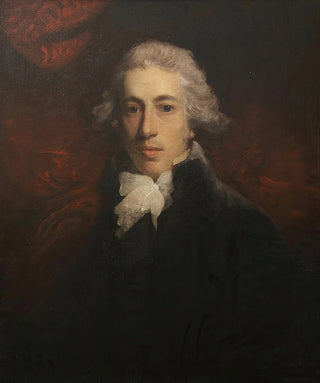Art print | Thomas Erskine Lord Chancelier - John Hoppner


View from behind

Frame (optional)
In the world of 18th-century British painting, certain works stand out for their ability to capture the very essence of their subject. Among these, the depiction of Thomas Erskine, Lord Chancellor, by John Hoppner, emerges as a shining example of portraiture. This artwork, which transcends mere representation, invites the viewer to delve into the complex universe of the politics and society of the time. The piece, both majestic and intimate, reveals not only the power and authority of its subject but also an artistic sensitivity that has made Hoppner's reputation. By contemplating this art print, one cannot help but be struck by the depth of exchanged gazes and the richness of details that compose this historical scene.
Style and uniqueness of the work
John Hoppner's style is characterized by a remarkable mastery of portraiture, where each stroke and color seems carefully chosen to evoke a particular atmosphere. In the depiction of Thomas Erskine, the artist manages to balance the authority of the character with a certain vulnerability, thus creating a subtle dialogue between power and humanity. The play of light, delicate shadows, and the chosen color palette testify to a refined technique that brings the canvas to life. Hoppner also uses clever compositional elements, placing Erskine in a frame that emphasizes his status while making him accessible. This portrait is a true invitation to explore the nuances of his subject's personality, revealing a man who is both powerful and thoughtful, engaged in the affairs of his time.
The artist and his influence
John Hoppner, born in 1758, established himself as one of the most influential portraitists of his era. Raised in a rich artistic environment, he was trained under the guidance of iconic figures such as Sir Joshua Reynolds. His style, although deeply rooted in the tradition of British portraiture, is enriched with a romantic sensitivity that sets him apart from his contemporaries. Hoppner captured the spirit of his time through a gallery of characters ranging from aristocrats to political figures, each carrying within him a story

Matte finish

View from behind

Frame (optional)
In the world of 18th-century British painting, certain works stand out for their ability to capture the very essence of their subject. Among these, the depiction of Thomas Erskine, Lord Chancellor, by John Hoppner, emerges as a shining example of portraiture. This artwork, which transcends mere representation, invites the viewer to delve into the complex universe of the politics and society of the time. The piece, both majestic and intimate, reveals not only the power and authority of its subject but also an artistic sensitivity that has made Hoppner's reputation. By contemplating this art print, one cannot help but be struck by the depth of exchanged gazes and the richness of details that compose this historical scene.
Style and uniqueness of the work
John Hoppner's style is characterized by a remarkable mastery of portraiture, where each stroke and color seems carefully chosen to evoke a particular atmosphere. In the depiction of Thomas Erskine, the artist manages to balance the authority of the character with a certain vulnerability, thus creating a subtle dialogue between power and humanity. The play of light, delicate shadows, and the chosen color palette testify to a refined technique that brings the canvas to life. Hoppner also uses clever compositional elements, placing Erskine in a frame that emphasizes his status while making him accessible. This portrait is a true invitation to explore the nuances of his subject's personality, revealing a man who is both powerful and thoughtful, engaged in the affairs of his time.
The artist and his influence
John Hoppner, born in 1758, established himself as one of the most influential portraitists of his era. Raised in a rich artistic environment, he was trained under the guidance of iconic figures such as Sir Joshua Reynolds. His style, although deeply rooted in the tradition of British portraiture, is enriched with a romantic sensitivity that sets him apart from his contemporaries. Hoppner captured the spirit of his time through a gallery of characters ranging from aristocrats to political figures, each carrying within him a story






